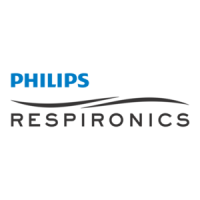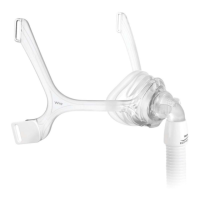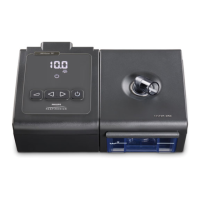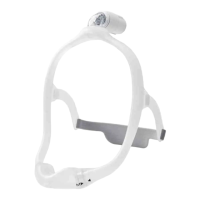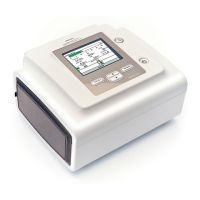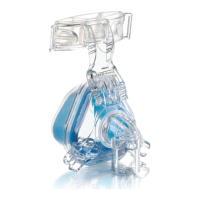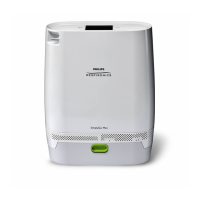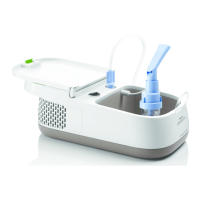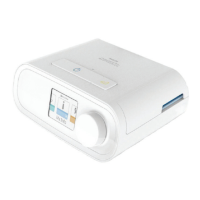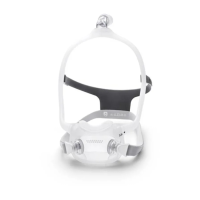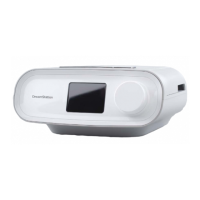Do you have a question about the PHILIPS Respironics Trilogy 100 and is the answer not in the manual?
Lists the components included with the Trilogy 100 system, such as the device, carrying case, and accessories.
Describes the purpose and patient population for the Trilogy 100 system, including indications and contraindications.
Details important safety warnings and cautions for device operation, personnel qualifications, and electrical interference.
Describes the controls, indicators, and display on the device's front panel, including buttons and LEDs.
Details the connectors and features located on the device's sides and rear, such as power inlets and ports.
Explains the different ventilation modes (PCV, VCV) and their operational types.
Describes the types of breaths (Spontaneous, Mandatory, Assisted, Sigh) used in therapy modes.
Details features like Flex, Ramp, Rise Time, AVAPS, Flow Patterns, Sigh, and Triggering.
Lists and describes various high, medium, and low priority ventilator alarms and their causes.
Details on powering the ventilator using AC, detachable, or internal batteries and their indicators.
Instructions for connecting the patient circuit, including passive and active exhalation devices.
Explains how to enable/disable and use the keypad lock to prevent accidental changes.
Describes how to navigate to and view the device's startup and monitor screens.
Details various indicators displayed on the Monitor Panel, Measured Settings Panel, and Status Panel.
Guides on accessing and modifying settings when the device is in Full Menu Access mode.
Steps for connecting the configured ventilator to the patient after system checkout.
Explains how audible and visual indicators signal different alarm types and priorities.
Step-by-step guide on how to respond to a device alarm effectively.
Procedures for cleaning the exterior of the ventilator and detachable battery.
Instructions for cleaning and replacing the reusable foam air inlet filter.
Guidance on cleaning reusable patient circuits and following institutional protocols.
Steps to resolve issues when the device fails to power on.
Troubleshooting steps for unexpected device performance issues.
Addresses issues related to warm air from the mask and proper device ventilation.
Details how to connect supplemental oxygen and factors affecting concentration.
Instructions for inserting and using an SD card for data recording.
Steps to prepare the device for settings and alarms tests, including connecting power and test lung.
Detailed procedures for testing device settings and alarms, including specific values.
Specifies operating and storage conditions for temperature, humidity, and atmospheric pressure.
Details electrical specifications like voltage sources, battery capacity, and protection types.
Provides accuracy specifications for various control parameters like IPAP, EPAP, Tidal Volume, etc.
Lists terms and acronyms used in the manual with their definitions.
Information on electromagnetic emissions and compliance.
Details electromagnetic immunity tests and compliance levels.
Lists the components included with the Trilogy 100 system, such as the device, carrying case, and accessories.
Describes the purpose and patient population for the Trilogy 100 system, including indications and contraindications.
Details important safety warnings and cautions for device operation, personnel qualifications, and electrical interference.
Describes the controls, indicators, and display on the device's front panel, including buttons and LEDs.
Details the connectors and features located on the device's sides and rear, such as power inlets and ports.
Explains the different ventilation modes (PCV, VCV) and their operational types.
Describes the types of breaths (Spontaneous, Mandatory, Assisted, Sigh) used in therapy modes.
Details features like Flex, Ramp, Rise Time, AVAPS, Flow Patterns, Sigh, and Triggering.
Lists and describes various high, medium, and low priority ventilator alarms and their causes.
Details on powering the ventilator using AC, detachable, or internal batteries and their indicators.
Instructions for connecting the patient circuit, including passive and active exhalation devices.
Explains how to enable/disable and use the keypad lock to prevent accidental changes.
Describes how to navigate to and view the device's startup and monitor screens.
Details various indicators displayed on the Monitor Panel, Measured Settings Panel, and Status Panel.
Guides on accessing and modifying settings when the device is in Full Menu Access mode.
Steps for connecting the configured ventilator to the patient after system checkout.
Explains how audible and visual indicators signal different alarm types and priorities.
Step-by-step guide on how to respond to a device alarm effectively.
Procedures for cleaning the exterior of the ventilator and detachable battery.
Instructions for cleaning and replacing the reusable foam air inlet filter.
Guidance on cleaning reusable patient circuits and following institutional protocols.
Steps to resolve issues when the device fails to power on.
Troubleshooting steps for unexpected device performance issues.
Addresses issues related to warm air from the mask and proper device ventilation.
Details how to connect supplemental oxygen and factors affecting concentration.
Instructions for inserting and using an SD card for data recording.
Steps to prepare the device for settings and alarms tests, including connecting power and test lung.
Detailed procedures for testing device settings and alarms, including specific values.
Specifies operating and storage conditions for temperature, humidity, and atmospheric pressure.
Details electrical specifications like voltage sources, battery capacity, and protection types.
Provides accuracy specifications for various control parameters like IPAP, EPAP, Tidal Volume, etc.
Lists terms and acronyms used in the manual with their definitions.
Information on electromagnetic emissions and compliance.
Details electromagnetic immunity tests and compliance levels.
| Brand | PHILIPS Respironics |
|---|---|
| Model | Trilogy 100 |
| Category | Medical Equipment |
| Language | English |
